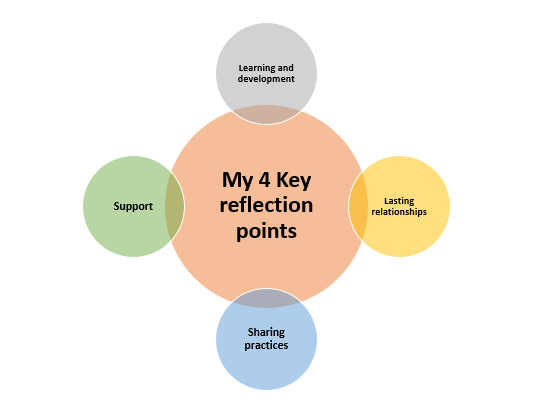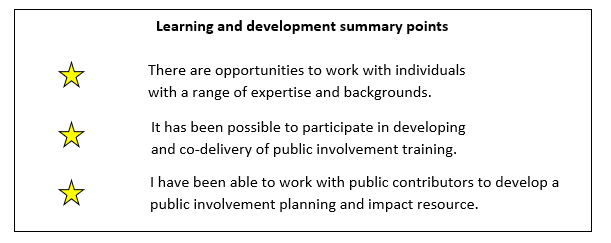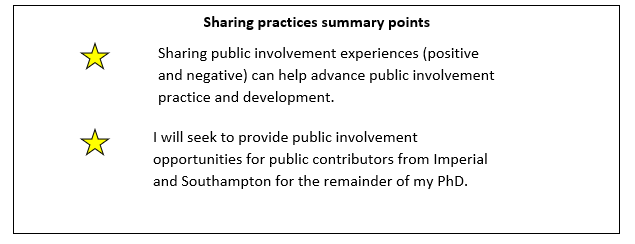My name is Carmel McGrath, and I am in the final year of my PhD at the University of Southampton. My research is exploring the impacts of Public Involvement. In July 2020, I started a virtual placement at the National Institute for Health Research (NIHR) Imperial Biomedical Research Centre (BRC) following a successful application for the NIHR Short Placement Award for Research Collaboration (SPARC) scheme. These awards aim to promote collaborations across Biomedical Research Centres so early career researchers can network, train in a specific skill or collaborate with other researchers/specialist outside of their own centres.
I have now completed my placement and would like to share my experiences in three separate blog posts. For my first entry, I will be outlining four key reflections from my time with the Imperial Patient Experience Research Centre (PERC) and discuss the ways in which they have contributed towards my PhD and future career as a researcher.

A diagram representing my 4 key reflection points as a result of working with the PERC team.
My key reflections:
1. Learning and development

I was eager to start my placement with PERC which hosts a large multi-disciplinary team of professionals including public health researchers, research nurses, anthropologists, data scientists and public involvement and engagement experts.
At the very start of my placement, I was invited to attend the weekly PERC meetings, where I was introduced to the team and was offered the chance to get involved, or observe, any activities that I felt would be valuable for my learning needs.
A key development goal I had was to enhance my teaching skills. With support from Maria Piggin, Training and Partnerships Manger at PERC I was able to assist in running the current public involvement training that is offered by Imperial College London, as well as co-delivering public involvement training to Cancer Research UK PhD students, medical and allied health professionals alongside Maria and public contributors.
I also had the opportunity to review the new Imperial College London public involvement Massive Open Online Courses on Coursera, which helped consolidate my knowledge and taught me new information about public involvement.
During this placement, I have also been co-developing a public involvement planning and impact resource. This included bringing in user-centred design by having discussions with researchers and public contributors about the benefits, potential applications and improvements based on their feedback and use of the resource in practice (I will be writing more about this in future blogs!).
As part of this work, I have worked closely with two public contributors from the Imperial BRC Public Advisory Panel, Maisie and Sandra. Maisie, a public contributor, has provided a short reflection of her experiences of working with me during my placement:
‘I have been working with Carmel to help in the development of a public involvement planning and impact resource for researchers. I have been involved in the reviewing and providing feedback on the tool as well as providing some suggestions for the infographic that is being developed alongside the tool. The involvement and learning have been great, comments to Carmel either one to one or in a group have been listened to, taken on, welcomed and used to inform the Project. I have felt able to make a useful a positive contribution to the development of the tool and infographic’.
2. Support

Prior to beginning my placement, I was allocated a supervisor, Dr. Kathryn Jones. Kathryn and I both have nursing backgrounds and whilst on placement, Kathryn provided me with support both as a researcher and a nurse. We would have regular check-ins to discuss my progress as well as my personal wellbeing, development and training, and career prospects.
Due to the support provided to me, I felt confident and able to offer my support to others, including researchers who were new to public involvement. A significant achievement for me was helping a researcher successfully plan and structure her first public involvement meeting. The aim of this meeting was to inform a public involvement strategy for her future work based on the framework developed from my research. Being involved in this activity, not only helped to support the research being undertaken but also provided reciprocal benefits. It helped me to identify areas for refinement of the framework being developed as part of my own PhD and provided an opportunity for me to link theory to practice.
3. Building relationships

Although it has not been possible to meet face-to-face, I have still formed close relationships with members of the PERC team, including the public contributors, on both a personal and professional level.
The start date of my placement was meant to be March 2020, however due to the COVID-19 pandemic I suspended my PhD studies for three months to return to intensive care nursing. During this time, I remained in close contact with my placement contacts, Kathryn, Maria and Philippa who all provided me with moral support and kept me updated. Their understanding and support at this time was invaluable and they ensured when I returned, I could begin my virtual placement.
Whilst on placement, I have also had the chance build connections with other PhD students and work with researchers. The aims of the SPARC placements are to encourage ongoing collaborations and this placement certainly has done that. Although the placement has now ended, I plan to stay in contact and continue to work with those I have met and worked with throughout my placement.
4. Sharing practices

During my placement, I have been in the unique position to be able to reflect on, and compare, public involvement practices at both Imperial and Southampton BRCs. This has been extremely beneficial as I am now able to share examples of good practice and learning relating to public involvement across both BRC’s.
Something that stood out to me was the contribution and impact of one public contributor, Sandra, who was involved in several initiatives across Imperial. Sandra shared her experience of working on various research projects while co-delivering the public involvement training to PhD students, medical and allied health professionals.
I learnt a lot from Sandra’s presentation during the training session. Although the public involvement training covered similar content to Southampton’s training (which is a good indication of promoting high standards of public involvement practices across BRC’s), Sandra reflected on her various experiences of working with different research teams in which she had the opportunity to undertake different roles and responsibilities namely being a co-applicant, helping to create infographics and being a co-author on a paper. Sandra’s honest account of her experiences was different to those I had heard from our public contributors at Southampton providing me with new insights into public involvement. This highlighted the importance of working with different public contributors across BRC’s and the value of sharing experiences (both positive and negative) of public involvement across research contexts. As a result of this placement, I have been able to ensure a greater diversity of public views feeding into my PhD project, and I plan to continue working with the public contributors I have built relationships with at Imperial and provide them with opportunities to be involved in my future PhD activities.
Final reflections
Spending time with the PERC team, public contributors and researchers has been invaluable. I have considerably widened my knowledge and expertise both as a researcher and for my future public involvement practices. By working with and learning from individuals who were willing to support me I was able to maximise the range of opportunities the NIHR Imperial BRC had to offer.
What next?
I will be writing a follow-on blog about the process of co-creating a public involvement planning and impact resource that is currently being developed in collaboration with public contributors and researchers from Imperial. Keep an eye on the PERC blog for my next entry.
If you are interested in doing a short-term placement at PERC you can get in touch with the team to discuss further at: publicinvolvement@imperial.ac.uk

This blog entry has been written by:
Carmel McGrath- PhD student funded by the National Institute of Health Research Southampton Biomedical Research Centre and the University of Southampton. Her PhD explores the impacts of Patient and Public Involvement on health research.
Email: cm31g13@soton.ac.uk Twitter: @McGrathCarmel93
